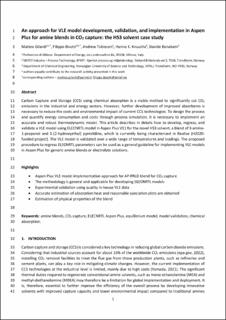| dc.contributor.author | Gilardi, Matteo | |
| dc.contributor.author | Bisotti, Filippo | |
| dc.contributor.author | Tobiesen, Finn Andrew | |
| dc.contributor.author | Knuutila, Hanna Katariina | |
| dc.contributor.author | Bonalumi, Davide | |
| dc.date.accessioned | 2024-01-17T13:37:58Z | |
| dc.date.available | 2024-01-17T13:37:58Z | |
| dc.date.created | 2023-06-07T16:30:08Z | |
| dc.date.issued | 2023 | |
| dc.identifier.citation | International Journal of Greenhouse Gas Control. 2023, 126: 103911. | en_US |
| dc.identifier.issn | 1750-5836 | |
| dc.identifier.uri | https://hdl.handle.net/11250/3112226 | |
| dc.description.abstract | Carbon Capture and Storage (CCS) using chemical absorption is a viable method to significantly cut CO2 emissions in the industrial and energy sectors. However, further development of improved absorbents is necessary to reduce the costs and environmental impact of current CCS technologies. To design the process and quantify energy consumption and costs through process simulation, it is necessary to implement an accurate and robust thermodynamic model. This article describes in details how to develop, regress, and validate a VLE model using ELECNRTL model in Aspen Plus V11 for the novel HS3 solvent, a blend of 3-amino-1-propanol and 1-(2-hydroxyethyl) pyrrolidine, which is currently being characterized in Realise (H2020-funded project). The VLE model is validated over a wide range of temperatures and loadings. Deviations on CO2 partial pressures and heat of absorption are lower than 15% and 8%, respectively. The proposed procedure to regress ELECNRTL parameters can be used as a general guidelin | en_US |
| dc.language.iso | eng | en_US |
| dc.publisher | Elsevier | en_US |
| dc.rights | Navngivelse 4.0 Internasjonal | * |
| dc.rights.uri | http://creativecommons.org/licenses/by/4.0/deed.no | * |
| dc.title | An approach for VLE model development, validation, and implementation in Aspen Plus for amine blends in CO2 capture: the HS3 solvent case study | en_US |
| dc.title.alternative | An approach for VLE model development, validation, and implementation in Aspen Plus for amine blends in CO2 capture: the HS3 solvent case study | en_US |
| dc.type | Peer reviewed | en_US |
| dc.type | Journal article | en_US |
| dc.description.version | acceptedVersion | en_US |
| dc.source.volume | 126 | en_US |
| dc.source.journal | International Journal of Greenhouse Gas Control | en_US |
| dc.identifier.doi | 10.1016/j.ijggc.2023.103911 | |
| dc.identifier.cristin | 2152809 | |
| dc.relation.project | EC/H2020/884266 | en_US |
| dc.source.articlenumber | 103911 | en_US |
| cristin.ispublished | true | |
| cristin.fulltext | postprint | |
| cristin.qualitycode | 1 | |

